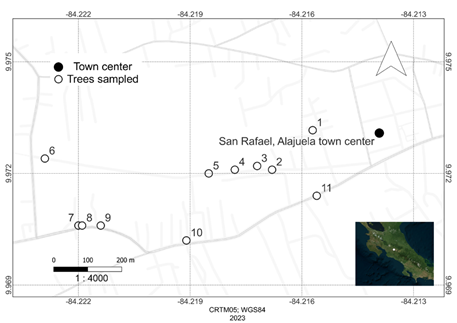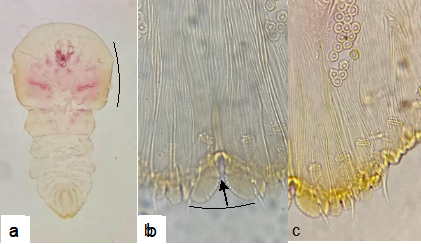Introduction
Mango (Mangifera indica L.: Anacardiaceae) is widely cultivated in India and other tropical and subtropical countries in Southeast Asia and America (Lo Verde et al. 2020). In Costa Rica around 8200 hectares are dedicated to the production of this crop (Ureña-Bogantes et al. 2007). More than 400 species of phytophagous insects and mites have been reported on mango in different regions of the world, among them scale insects (Hemiptera: Coccomorpha) (Reddy et al. 2018). Scale insects are sap-sucking plant parasites that can be found almost anywhere that plants grow. Currently, there are at least 8194 described species, classified in 50 families (García Morales et al. 2016).
Armored scale insects (Hemiptera: Coccomorpha: Diaspididae) comprise the most diverse family of scale insects, with over 2600 species (García Morales et al. 2016, Normark et al. 2019). They have been identified as pests of perennial plants worldwide and are among the world's most invasive species (Miller y Davidson 2005). Around 73 species of armored scale insects are associated with mango worldwide, and among them Aulacaspis tubercularis Newstead is one of the most serious pests of mangos in many parts of the world (García Morales et al. 2016). This species, known as the white mango scale, affects the commercial value of fruits and their export potential wherever it is present (Lo Verde et al. 2020, del Pino et al. 2020). In the present work, we report for the first time the occurrence of A. tubercularis in Costa Rica.
Materials and methods
Surveys were conducted in San Rafael, which is located in the central canton of Alajuela province in the Greater Metropolitan Area of Costa Rica (Figure 1). A total of eleven sites were sampled: the first, where Aulacaspis tubercularis was initially seen, was sampled in March 2020, and the remaining ten were sampled in September 2022. Infested leaves were collected, kept in the Entomology Laboratory of the Biology School at the University of Costa Rica and observed under a stereomicroscope Olympus SZ61. Insects found on leaves were photographed and were put in ethanol (70%). Slide mounts of some adult females were prepared following the procedures described by Watson and Chandler (2000).

Figure 1 Location of the trees sampled in San Rafael town in the city of Alajuela, Costa Rica, 2022.
Slide mounted specimens were examined with transmitted light using a Swift SW350T Microscope (Swift Optical Instruments, Inc.). Specific identification was confirmed using the keys given in Watson (2002) and Wei et al. (2016). Specimens are deposited in the Zoology Museum of the University of Costa Rica. In order to estimate percent of parasitism and predation, adult females in the samples were examined under a stereomicroscope. In many cases the scale insects themselves were missing, but the condition of their wax covering provided evidence of activity by natural enemies. As described by Tooker and Hanks (2000), a circular hole in the wax covering is evidence of successful emergence by a parasitoid wasp whereas a ragged hole is evidence of predation by an insect with chewing mouthparts. Adult females that had apparently been killed by fungi were excluded.
Results and discussion
The armored scale was identified as Aulacaspis tubercularis (Diaspididae) (Figures 2 and 3). As indicated by Watson (2002), in life the exposed body of a gravid adult female is 1.5-2.0 mm long and brownish colored (Figure 2a). The scale cover of the adult female is approximately circular, white and/or transparent, with dark, oval exuviae (Figure 2b). A. tubercularis was found infesting fruits (Figue 2c), leaves (Figure 2d) and trunk; as has been reported previously (Lo Verde et al. 2020, del Pino et al. 2022). Other Diaspididae identified on the sampled mango trees included Pseudaonidia trilobitiformis (Green) and Ischnaspis longirostris (Signoret).

Figure 2 Live Aulacaspis tubercularis on mango: a. Adult female b. Female scale cover; c. Mango fruit infested with A. tubercularis; d. A. tubercularis on mango leaf. Alajuela, Costa Rica, 2020.
The slide-mounted adult female has a swollen, angular or quadrate prosoma, with the body widest at the prominent lateral tubercles, almost level with anterior spiracles (Figure 3a); the posterior spiracles are usually associated with spiracular pores; gland spines and macroducts are absent from the thorax and head. The pygidium has median lobes linked by internal sclerotization (zygotic), without any setae or gland spines between their bases (Figure 3b); with a pair of elongate scleroses on the base of L1; only 1 dorsal macroduct present on abdominal segment VI (Figure 3c) (Watson 2002, Wei et al. 2016).

Figure 3 Slide-mounted adult female of Aulacaspis tubercularis: a. Whole body; b. Pygidium with arrow indicating zygotic median lobes without any setae or gland spines between their bases; c. Abdominal segments VI-VIII.
Aulacaspis tubercularis was found on 90% of the mango trees sampled. Examination of the scale covers for signs of mortality due to natural enemies showed that 12% of the adult females had evidence of predation and 2.5% had evidence of parasitization (Table 1). However, these are undoubtedly subestimates of actual mortality since evidence of host feeding by adult parasitoids and predation by arthropods with piercing mouthparts is more difficult to detect (Abram et al. 2019).
Conclusion
The armored scale Aulacaspis tubercularis was recorded for the first time in Costa Rica, affecting 90% of the mango trees examined in an urban environment in the town of San Rafael in the city of Alajuela. This species has previously been recorded from 73 countries including the United States, Mexico, Colombia, Venezuela and several Caribbean countries (García Morales et al. 2016). The previous report from Central America is El Salvador, Honduras and Guatemala (Natural History Museum 2022, Azrag et al. 2022). A. tubercularis is associated with 37 genera of plants in 22 families, often becoming extremely numerous, and this species therefore has considerable quarantine importance (Watson 2002, García Morales et al. 2016). Further investigations on the population dynamics and natural enemies are needed to provide useful information in order to implement adequate control strategies.















